Genre: Fighting Developer: Atlus Publisher: Atlus Players: 1-2 Released: 1994
In the wake of the fighting game craze initiated by the success of Street Fighter II, many developers tried to jump onto the running train and created their own take on the genre. A few of them succeeded, like SNK with Fatal Fury or Midway with Mortal Kombat, who managed to make just enough difference in their adaptations that they managed to leave a lasting impression and spun off into long series of their own. There were games that tried to stand out by special gimmicks with varying to little success, like the stop-motion Clayfighter, the dino brawler Primal Rage, or the furry fighter Brutal: Paws of Fury. Then there were countless rather uninspired knockoffs, games like World Heroes for example, that didn’t manage to really stand out in their own right and are now considered to be mediocre at best or forgettable at least.
And then we got Gōketsuji Ichizoku or, as it’s better known among Western audiences, Power Instinct. Developed and released by none other than Atlus (of Megami Tensei and Persona fame), the game lands smack dab in the middle of all of this. From its rather meager beginnings it became the starting point of a respectable series in its own right spanning seven games (the latest, Gōketsuji Ichizoku Matsuri Senzo Kuyou, was released in 2009). The first installment hit the arcades in November 1993 and did well enough to receive home console ports for the SNES and the Mega Drive/Genesis, though the latter was only released in Japan. While a seemingly rather generic fighter at first glance, the game sports a few interesting quirks that might warrant taking a closer look, assuming you like a dab of weirdness in your fighting games.
Just like many of its peers, Gōketsuji Ichizoku (loosely translated into “the Gōketsuji Clan”) comes in the guise of a tournament fighter. Eight members of the huge Gōketsuji family (which apparently has members all over the world, including Japan, China, Italy and even a Native American tribe) come together to fight over replacing 78-year-old Oume as the new head of the rich and influential clan. It’s standard practice for the genre; they do so in a series of best-of-three fights until they can challenge and defeat the final boss.
Those only vaguely familiar with the series, or those who may have played a few of the later entries, may have heard that the main reason why Power Instinct series managed to stand out a bit from the masses of fighting games was its roster of quirky, if not outlandishly weird characters. The sequel to the first Power Instinct and later installments like Groove On Fight or Matrimelee introduced figures like a scantily-clad time traveling cop from the future, a magical girl capable of transforming into a roller-blading adult form, a chubby Hawaiian teenager entering combat with a flabby shirt and no pants and underwear or a guy in a dog costume into the mix. The cast of the first game, by comparison, is boring for the most part – maybe aside for the fact that for such an early fighting game it has a relatively high number of female protagonists (four out of nine, if you include the boss). Most of the eight people in the roster are fairly generic: You have the generic Japanese Karateka, the generic ninja, the generic Chinese monk, the generic girl (who really doesn’t have any standout features other than being female) or the generic American street tough. The two largest playable characters manage to stand out a little more, if only by character design: The Italian Amazon-style strong woman, who’s basically just a female version of the generic wrestler, and the aforementioned Native American – though Super Street Fighter, which had T. Hawk as a playable character, had come out a few months earlier, so the idea wasn’t hat original anymore. And then there’s Otane…
Remember the 78-year-old I mentioned two paragraphs earlier? Well, Otane is her twin sister! That’s right, you get to fight as an almost octogenarian granny. And boy, can she kick some ass! Not only is she pretty nimble for her age, but her attacks are rather unique, too. She has two different projectile attacks, one of which has her firing her dentures at you. She has a close-range blast move where she snaps at you with a freakishly blown-up spectral version of her creepy face. And one of her grappling holds has her giving her opponent a sloppy kiss, which draws energy from him… and with that, she rejuvenates herself and continues the fight as a younger woman, with faster attacks and a new set of special moves, for example firing rainbows. So yeah, this is a rather unique and weird character, and strangely enough, it makes a lot of fun playing her. The developers must have felt that way as well, since the boss character – her twin sister – is just an AI-controlled palette swap with increased speed, strength and resilience. It’s kinda cheap, but I admit, I haven’t had that much fun kicking the crap out of a geriatric person in a video game, including the final boss fight against Shang Tsung in the original Mortal Kombat.
Gameplaywise, there’s one other feature that helps the game distinguish itself from the competition. The stages are usually limited on both sides by in-game barriers suitable to the setting, like statues in a temple background or piles of tires in a car lot. If you manage to hit an opponent hard enough, it may result in him or her breaking through these obstacles, thus increasing the playfield by another screen. It’s a nice little touch that can liven up a battle. Sadly though, the Genesis port is missing the vertical scrolling the Arcade version had in the stages, but that is a relatively minor complaint. Thanks to this little gimmick and tight controls, fights can be fun and engaging, even between two of the stock characters. The fighters also move with a decent speed, so there’s a nice flow to the game.
Points have to be deducted for presentation, though. The games have a fair number of voice samples, but the quality is bad: they’re very garbled and scratchy, and there’s a strange, unpleasant reverb to all of them. The sound quality in general leaves a bit to be desired. The compositions by themselves aren’t that bad, but the sound quality is very tinny and lacking in depth. Similar things can be said about the graphics. The playable characters move decently and fluid, but the backgrounds seem washed out and meager, almost lifeless. There are worlds between these stages and the vibrant colors of any Street Fighter port on the Genesis. For a 1994 game you could really expect something better.
If you’re able to look past that, the game offers a variety of options to boost its replayability. Aside from the usual tournament and versus mode, you can also practice a bit or enter a “life attack” mode where you get tasked to defeat all the characters in the game with only one energy bar, like the survival modes of later fighting games. The Mega Drive version also has a group battle mode, where each side picks a team consisting of several characters – the members of each team can optionally keep hidden until they actually enter the fight, which is a nice touch. Those of you who are fluent in Japanese and prone to burst into song may also be happy to know that the game has a karaoke mode which allows you to sing along to the main theme and one of the stage tracks.
Gōketsuji Ichizoku is a decent fighter that plays smooth and fast but isn’t without flaws. The octogenarian granny is very fun and one of the quirkiest and freshest ideas I’ve seen in any 16-bit fighting game. Too bad the other seven selectable characters are very generic and uninspired – the standout features of the Power Instinct series didn’t really get to shine in this first installment. While the gameplay is pretty good, sound and graphics are sadly below average. All in all, the game is definitely worth a look and can be fun to play, but it isn’t really one of the big hitters.
Score: 6 out of 10


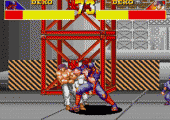
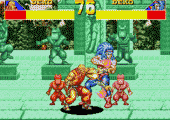
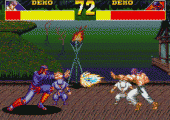
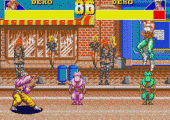
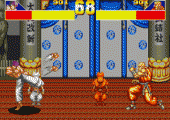
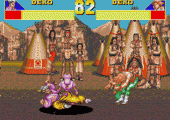
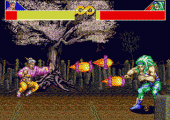
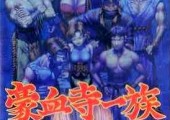
Recent Comments